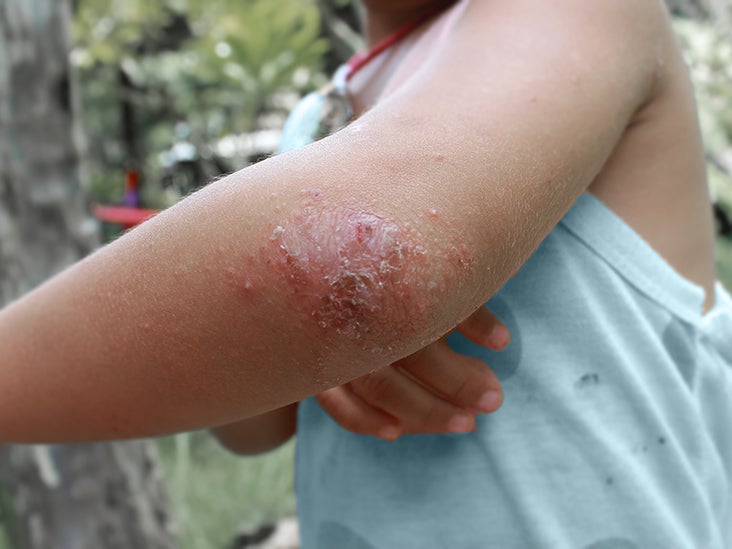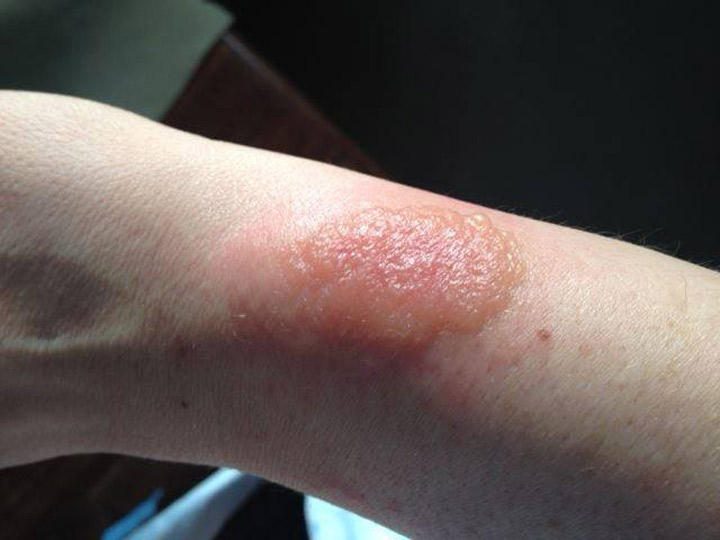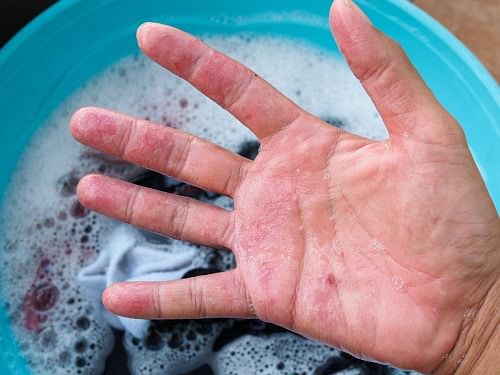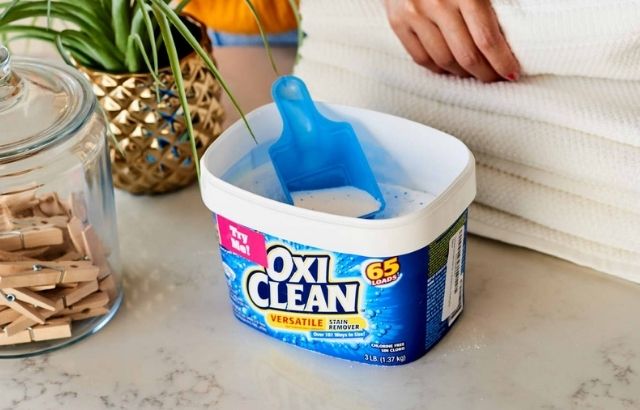To wash our clothes, we usually use a product or detergent of preference. But despite this, sometimes, for different reasons, we use another detergent, resulting in allergies. We can suffer some damage, such as chemical burns of the skin that must be treated immediately. In the United States and worldwide, it is known that there are people who suffer skin burns in a newspaper. Such burns are mostly a cause of the laundry detergent used. Therefore, we must know how to treat chemical burns from laundry detergent.
Ways to Treat Laundry Detergent Skin Burns

An effective way is to buy and apply a steroid ointment that contains a minimum of 1% hydrocortisone. These creams are sold in any pharmacy, and when applied to the affected area, they will relieve itching and inflammation.
Another alternative is to apply a kind of lotion that works against itching. A calamine lotion is recommended that soothes and helps the person not need to scratch.
Taking an antihistamine is another way to deal with chemical burns.
If you do not have any of these elements, creams, lotions, or antihistamine, you can take an oatmeal shower to relieve these symptoms or apply a wet compress to the entire affected area.
However, laundry detergents cause skin rash, and it is very convenient to know how to identify and treat it.
To achieve this in this article, we give you some tips below.
Unfortunately, some detergents have in their composition certain strong chemicals for the skin, which is why it is commonly normal for people to suffer allergic reactions.
- No matter how old you are, we are all susceptible to these chemicals like fragrances, dyes, and preservatives in laundry detergents. In this way, we can suffer eruptions as a result of the use of them.
- One of the consequences on the skin from the use of these detergents is called contact dermatitis.
- It usually occurs in the armpits and groin in a red rash accompanied by an itch. It can also occur completely throughout the body.
- These allergies can be experienced after the first exposure or after several continuous exposures.
- The best way to prevent this type of situation is by avoiding detergents with fragrances and colorants.
How to Treat Chemical Burns from Laundry Detergent

Common agents
Allergens
There are very irritating elements that are part of the composition of laundry detergents. Soaps, like all detergents in general, contain some agent with a surface action.
This releases the dirt and the amount of oil, causing its extermination during washing. On the other hand, some people have skin sensitivity to these agents or strong surfactants.
Other dangerous chemicals that can affect the skin with irritations and rashes are artificial fragrances. Industries that produce laundry detergents are used to using proprietary fragrance blends. Therefore, users are unaware of the components of these detergents.
There are other types of allergens in laundry detergents. Here are the most common ones: fabric softeners, preservatives, colours and dyes, parabens, thickeners and solvents, enzymes, humectants, and emulsifiers.
It is common for these mild allergen allergies to develop slowly. They are presented after repeated exposures. Although, when the allergy develops, minimal amounts of the offending substance are required to generate a reaction.
Contact dermatitis
It affects the skin when it comes in contact with metals, soaps, or plants. They can be of two classes: irritant or allergic. With the irritant, you experience a rash despite not being allergic to any laundry detergent.
Dermatitis is the most common non-allergic skin rash. If an irritating substance affects the top layer of the skin, it will cause an itchy rash.
Exposure to detergent for the first time or after repeated exposures may cause a reaction.
Allergic contact dermatitis happens when you react allergically to a substance. When you have an allergic reaction, your body triggers an immune response.
Symptoms
When we are allergic to any component of laundry detergent, we will present some symptoms. These symptoms may appear on the spot, just having contact with freshly washed clothes. Or, symptoms may appear after a few hours of contact.
Symptoms include mild or severe itching, swelling, mild or severe injuries, red rash, oozing or crusting blisters, dry skin, cracked or flaky skin, bumps, sensitive skin, and burning skin.
Contact dermatitis usually occurs when the skin comes into contact with an irritant. An example of this is the skin under the contact. But detergent may be the culprit if symptoms are widespread.
Symptoms can occur anywhere on the body as clothing comes into contact with it completely. A recent study found that the sweatier areas of clothing, like underarms and crotches, are more likely to stay wet for longer periods. A new study suggests people should pay extra attention to their sweaty spots to avoid many discomforts in the armpits and groin.
Another example is the sensitivity of the skin on our faces. If you wash a cover and the detergent is strong, it will affect your face.
Treatment
We can treat serious skin lesions from home.
There are home solutions to treat rashes. When a person is allergic to a chemical irritant such as a soap brand, it must be identified. This way, you can stop using it.
On the other hand, if you want to lessen your symptoms of chemical burns, follow the instructions below.
- Cream with steroids: This cream must contain in its composition at least 1% hydrocortisone. This will relieve itching and inflammation.
- Special lotion: This lotion should be medicated against itching like calamine that soothes the skin. This will prevent the person from scratching.
- Antihistamine: When you have an allergic reaction, it can be stopped with an antihistamine like Benadryl.
- Oatmeal bath: This bath is with cold oatmeal and will reduce itching and relieve inflamed skin.
- Wet compress: A washcloth or towel should be moistened with cold water to relieve inflammation. It will also help decrease sensitivity.
Prevention
- Avoid using detergents with fragrances and colorants.
- Artificial fragrances and dyes contain chemicals to which people are sensitive.
- These people should try detergent made from plants, so it does not contain dyes or fragrances. It is a natural alternative, for example, Seventh Generation Free and Clear.
Double rinse
Something very important is to prevent residues from being stored on your clothes when they are washed. One way to avoid this situation is to rinse it double.
Use hot water to kill allergens.
- Eliminate the use of fabric softeners and dryer sheets. Replace tumble dryer balls.
- Also, decrease the number of chemicals you use by eliminating fabric softener and dryer sheets.
- Drying balls are used to soften clothes and reduce static without adding irritants. These balls are usually made of wool, plastic, or rubber.
Vinegar and baking soda
- For natural cleaning, the most recommended is vinegar and baking soda.
- For the second wash cycle, use vinegar and baking soda. These do not irritate and therefore make it possible to lighten and soften clothes naturally.
Own detergent
- You can make your detergent using borax and soda.
- In this way, you will save money, and this type of solution will be fragrance-free or colourant-free.
- Adding Castile soap based on olive oil will give you extra cleaning power.
Washing machine
If we do loads with standard detergents and we have a family member with chemical sensitivities at home, let’s wash the washing machine after these.
As mentioned above, a cycle done using very hot water with baking soda and vinegar will kill the soap residue. It will also prevent the accumulation of chemicals from the machine.
Natural Treatment
Would you please not use chemical stain removers unless it is really necessary? Treat those stains with water, laundry soda, and baking soda.
Prospective analysis of pediatric ocular chemical burns: laundry detergent pods
According to 75% of cases, laundry detergent capsules are associated with a corneal epithelial defect. This rate is equivalent to other causes, which is higher than the conservative estimate of 14% previously reported among children with ocular exposure.
Significant Chemical Burns Associated with Dermal Exposure to Laundry Pod Detergent
There are serious consequences of using concentrated wash capsules. These can trigger significant clinical effects such as or pharyngeal burns and respiratory distress. Respiratory distress may be such that intubation is required.
So far, there is information on dermal burns. However, no serious isolated dermal injury events have been reported.
Toddler’s eye burns spike due to laundry detergent pods.
According to recently published research (At JAMA ophthalmology), laundry detergent capsules have increased eye burns in young children. These capsules for children are similar to candies, and therefore they are exposed to them.
Emergency Medical Care for Chemical Burns

If we realize or think that we have a chemical burn, we must follow these steps:
- Firstly, exterminate the cause of the burn.
- Then wash your skin with ordinary cold water for 10 minutes.
- If the chemical made contact with clothing or jewelry, remove them.
- Place a bandage on the burn.
- If required, rinse again with ordinary cold water.
Preventing Laundry Detergent Rashes

To prevent eruptions, we can follow the following tips:
- Do not use detergents with fragrances or colorants.
- When washing, rinse the load twice.
- Do not use fabric softeners or dryer sheets. Replace with tumble dryer balls.
- Use vinegar and baking soda.
- Wash the washing machine.
- Stains, you must treat it naturally.
Chemical Burns: Care Instructions

Previously, the steps to take immediately if you have a chemical burn were mentioned.
These include removing the cause of the burn, rinsing with cold plain water for 10 minutes, removing contaminated clothing and jewellery, bandaging the burn, and repeating rinsing if required.
Symptoms of chemical burns to the eye
The symptoms are as follows:
- Pain
- Burning sensation
- Redness
- Stinging
- Blurred vision
- Swollen eyelids
- Teary eyes
Use a fragrance- and dye-free detergent.
People with sensitive skin often use specific items, lotions, and cleansers to care for their skin. However, there is usually a product that is inadvertently omitted, “laundry detergent.”
This happens from the belief that rinsing clothes and bedding will completely remove the soap used. It turns out that small particles of used detergent can be stored in our clothes. These small particles can irritate the skin.
To avoid this, special detergents have been produced that do not irritate the skin. However, we must understand that if we have sensitive skin to these products, it does not mean that our clothes will be badly washed if we do not use them.
For this condition, there are many special detergents. We must use them with confidence and prevent burns on our skin. We have to select the right laundry detergent.
Rinse continuously with a clean toilet
As already mentioned, the first step is to take when suffering burns or irritations from laundry detergent is to rinse with cold water.
Frequently Asked Questions
Can you get chemical burns from laundry detergent?
Chemical burns to the eyes and skin may result from topical contact with a burst detergent pod. The chemical discomfort of the detergent pod contents is especially irritating to the eyes.
How long does it take for a laundry detergent rash to go away?
To properly treat contact dermatitis, you must first identify and prevent the source of your response. If the offending chemical is avoided, the rash generally clears itself in two to four weeks.
How long does a chemical burn take to heal?
Even small chemical burns may be excruciatingly painful. A small burn may heal in a matter of days. On the other hand, a more serious burn may take weeks or even months to heal entirely.
What are the symptoms of a chemical burn?
- Pain in the abdomen.
- Breathing problems.
- Skin and lips that are bright red or blue.
- Convulsions are a kind of seizure (seizures).
- Dizziness.
- Pain, burning, or watering of the eyes.
- Headache.
- As a result of an allergic response, you may have hives, itching, swelling, or weakness.
What does a bleach burn look like?
If you’ve already suffered a bleach burn, you might be able to treat it at home. Bleach burns resemble regular burns. Bleach burns, like heat burns, can cause severe discomfort, redness, swelling, blistering, or more serious skin injury.
Should you rinse a chemical burn with water?
Most chemical burns of the skin are treated by washing (flushing) the chemical off your body with a significant volume of room temperature water. However, this is not the case for all chemicals. To minimize additional problems, it is critical to treat the burn appropriately.
Can you put aloe vera on a chemical burn?
Apply a moisturizer to the burn area, such as aloe vera cream. This helps to keep the skin moist and reduces irritation. Itching can also be relieved by wearing loose, comfortable clothes.
What does a laundry detergent allergy look like?
Some of the signs of a soap allergy include a rash, such as hives; sneezing, or itchy water eyes, especially if you are sensitive to the fragrance of the product; and symptoms such as tightness in your skin, another rash, and itching, even after washing and using moisturizer.
What gets rid of a rash overnight?
- Apply a cold compress.
- Applying cold to a rash is one of the quickest and easiest ways to relieve the pain and itch.
- Oatmeal bath.
- Aloe vera (fresh).
- Coconut oil.
- Tea tree oil.
- Baking soda.
- Indigo naturalis.
- Apple cider vinegar.
What does a chemical burn look like on a child?
Mild chemical burns induce redness and discomfort and might resemble other common rashes or skin diseases, but severe chemical burns cause redness, blistering, skin peeling, and swelling.
How long does it take for a minor chemical burn to heal?
A small burn may heal in a matter of days. On the other hand, a more serious burn may take weeks or even months to heal entirely. When the skin is burned, it might get infected.
Can you get a chemical burn from laundry detergent?
Concentrated laundry pods have been linked to serious clinical consequences such as oropharyngeal burns and respiratory distress necessitating intubation.
Should Burns be kept moist or dry?
To keep the wound moist, use an antibiotic ointment or dressing. Cover the wound with gauze or a Band-Aid to keep it closed.
Is Vaseline good for burns?
Apply a thin coating of ointment to the burn, such as petroleum jelly or aloe vera. Antibiotics are not required in the ointment. Some antibiotic ointments have the potential to induce an allergic response.
When is a chemical burn bad?
If any of the following occur, contact your healthcare practitioner immediately: The swelling, discomfort, or redness worsens. The burn area drains fluid or pus. Fever of 100.4°F (38°C) or higher, or as advised by your healthcare provider.
What does Chemical Burn look like?
The surrounding region may appear black or white. You may not experience pain because your nerves are not suffering in the process.
Is it the most common type of burn injury to a child?
Thermal burns are the most frequent form of burn-in for children. Heat causes thermal injuries. Hot liquids (scalds), hot solids (contact burns), and flames can all cause them (flame burns).
Should you cover a burn or let it breathe?
To avoid placing pressure on burnt skin, wrap it loosely. Bandaging keeps air out of the wound, alleviates discomfort, and preserves blistering skin.
Bottom Line
Finally, we recommend that you keep all kinds of chemical products out of the reach of children.
For instance:
- Drain cleaners
- Metal cleaners
- Toilet bowl cleaners
- Strong acid or any acid.
It would help if you stored these are products in high places and not visible to avoid accidents. You have to be careful with different products that we adults commonly use at home, but that should not be visible to children or within reach of pets. So, this means that in this way, we will avoid entering an emergency department or hospital. The center of all this must be security!




